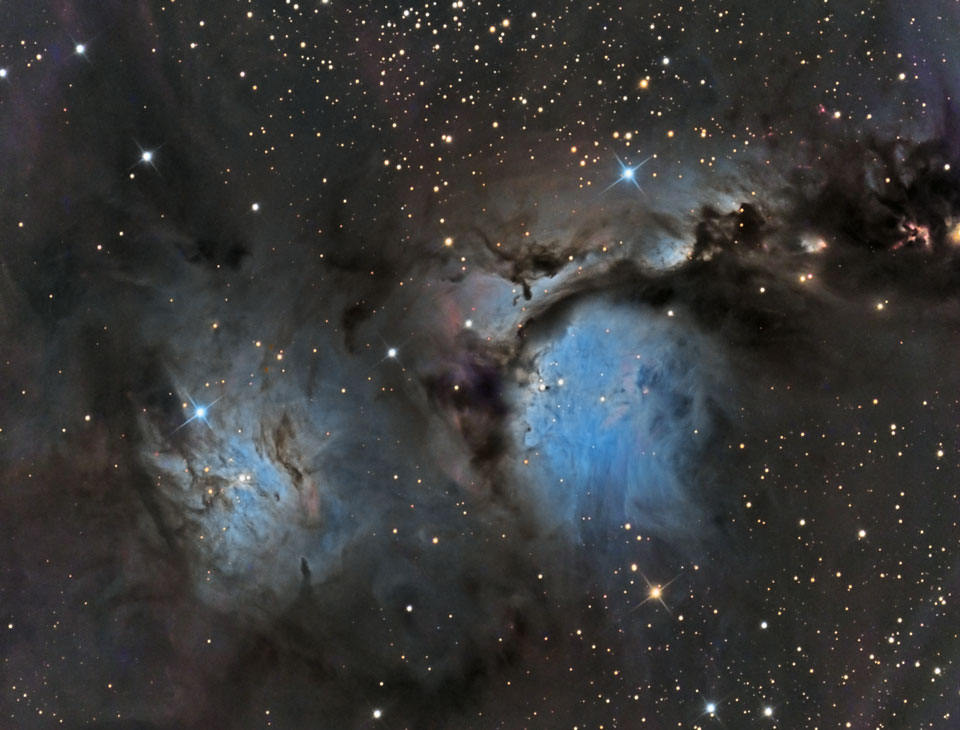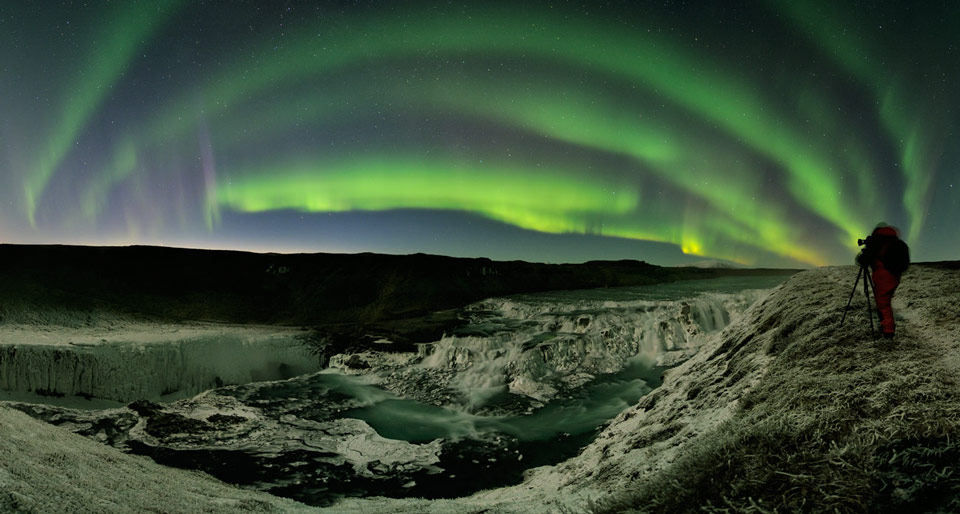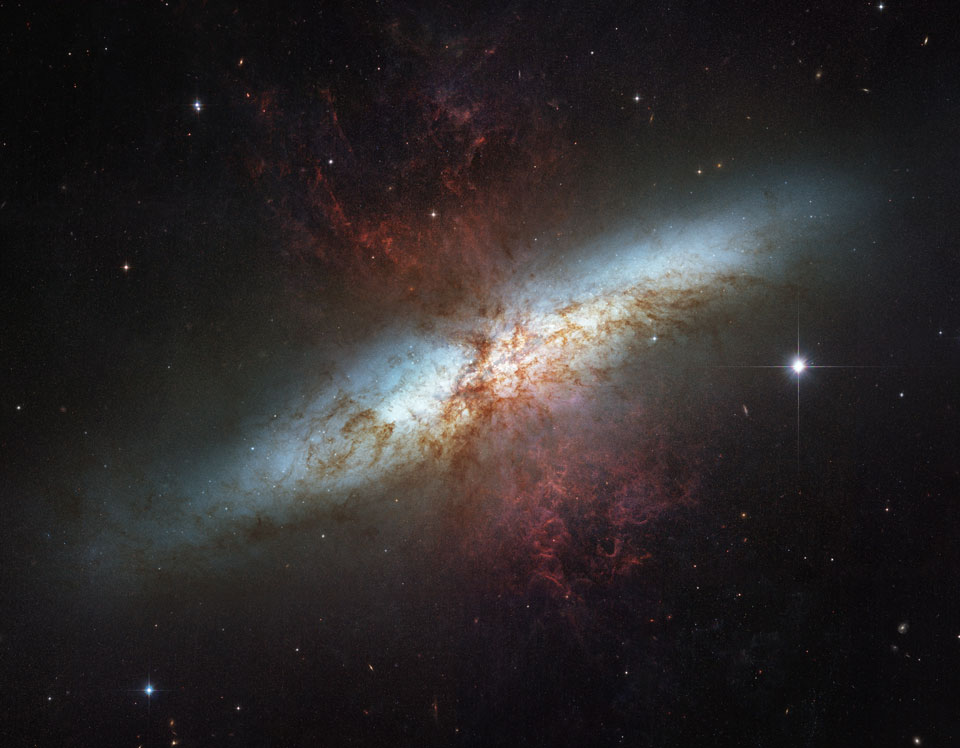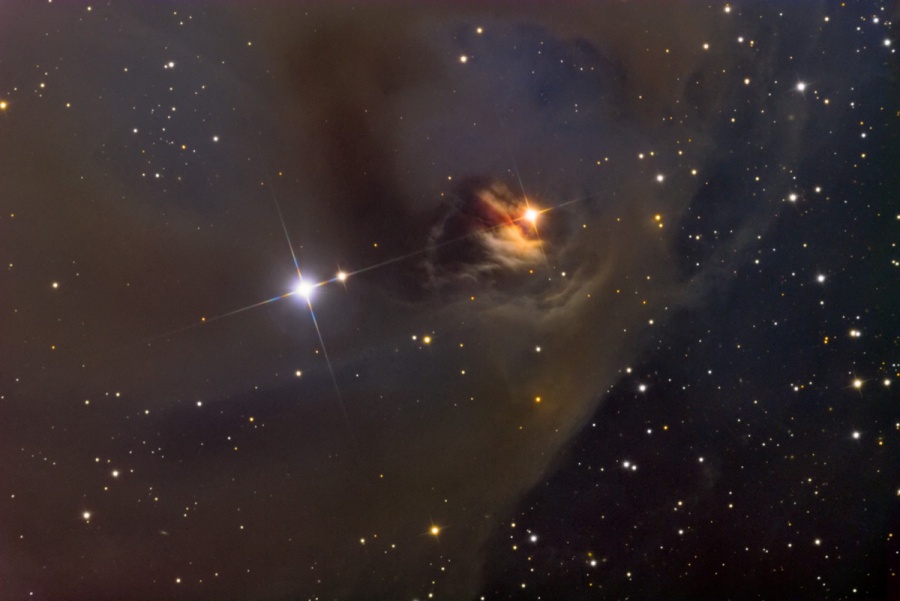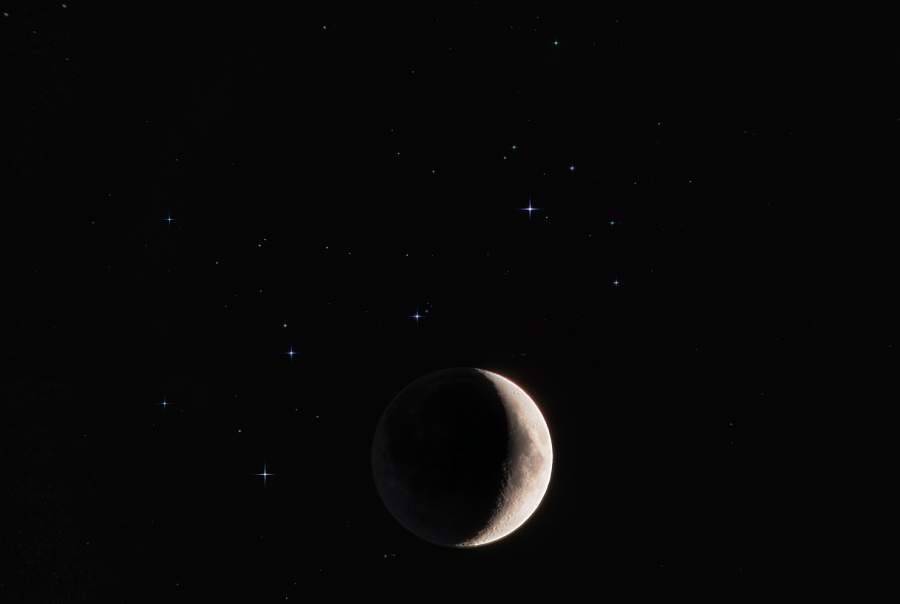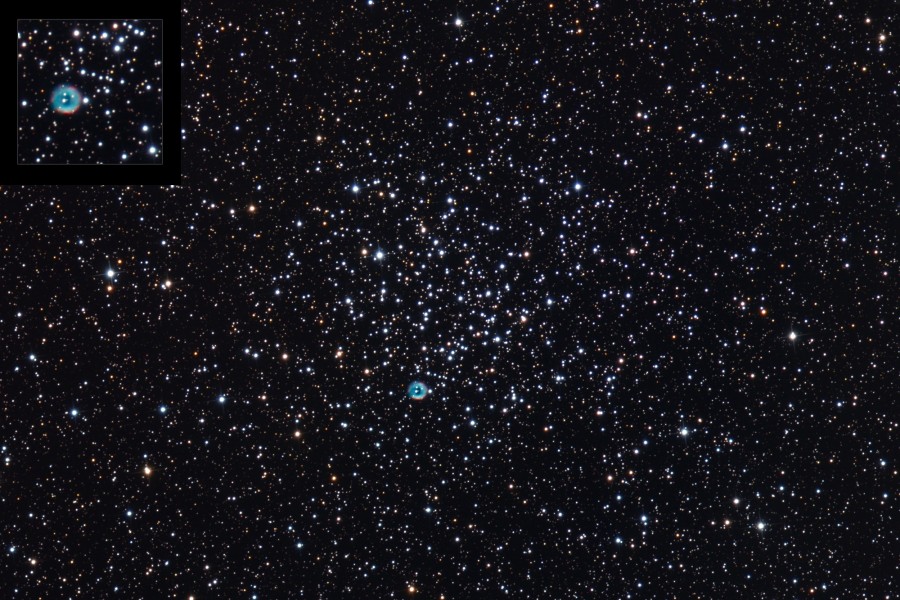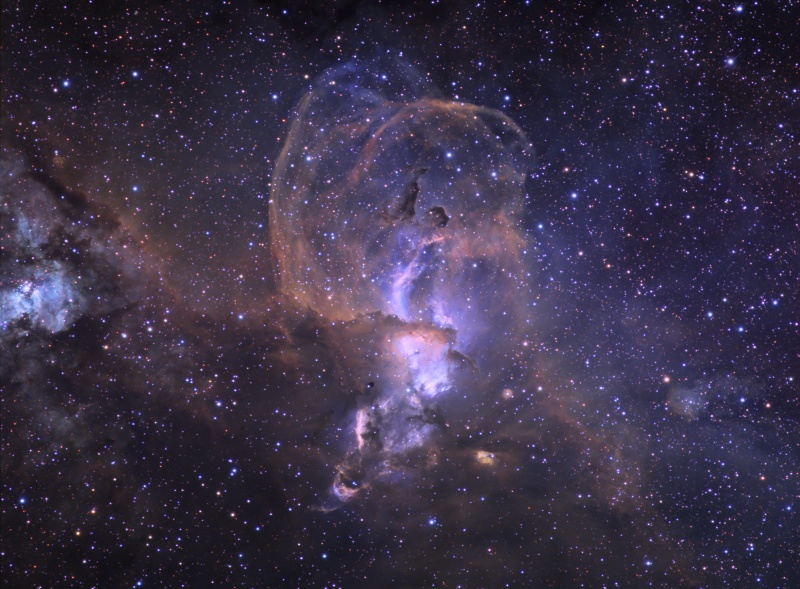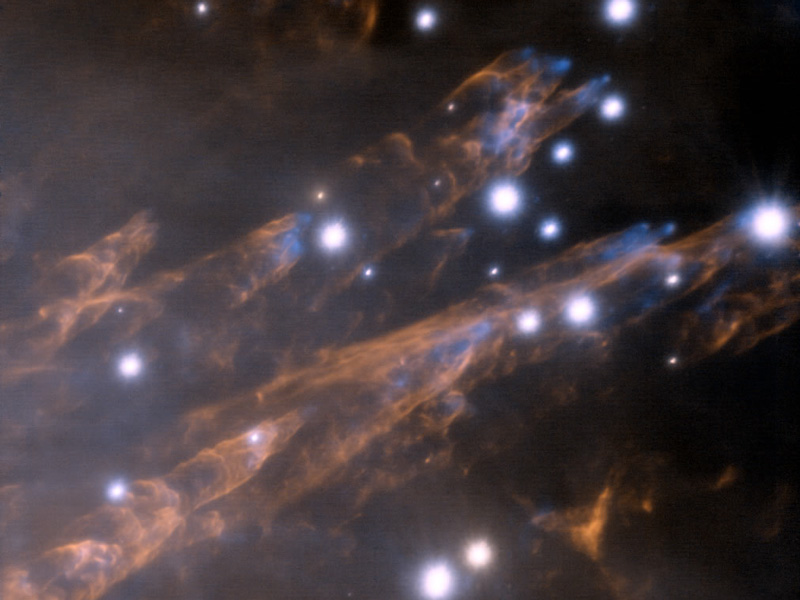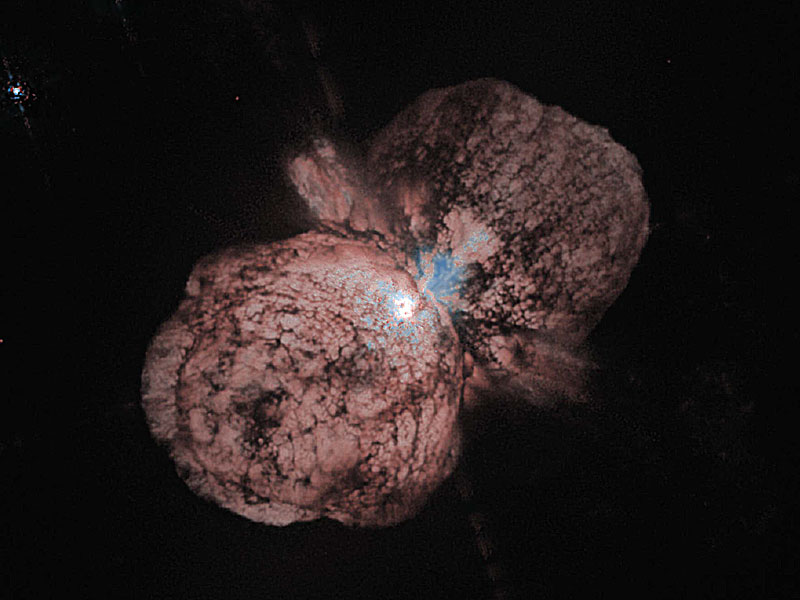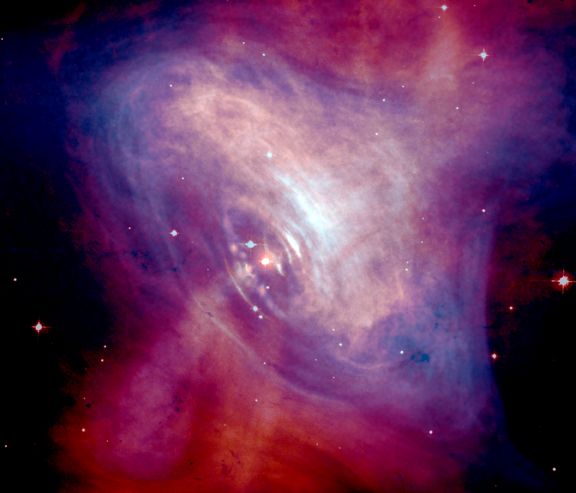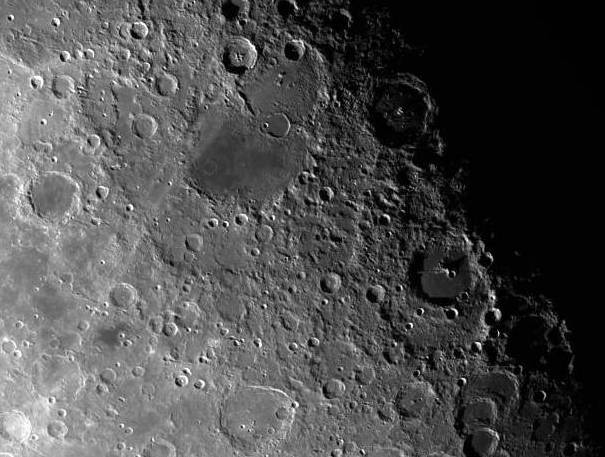| << Previous | Index | Next >> |
2015 As spring comes to planet Earth's northern hemisphere, familiar winter constellation Orion sets in early evening skies and budding trees frame the Hunter's stars. The yellowish hue of cool red supergiant Alpha Orionis, the great star Betelgeuse, mingles with the branches at the top of this colorful skyscape. Orion's alpha star is joined on the far right by Alpha Tauri. Also known as Aldebaran and also a giant star cooler than the Sun, it shines with a yellow light at the head of Taurus, the Bull. Contrasting blue supergiant Rigel, Beta Orionis, is Orion's other dominant star though, and marks the Hunter's foot below center. Of course, the sword of Orion hangs from the Hunter's three blue belt stars near picture center, but the middle star in the sword is not a star at all. A slightly fuzzy pinkish glow hints at its true nature, a nearby stellar nursery visible to the unaided eye known as the Orion Nebula.
2014 An eerie blue glow and ominous columns of dark dust highlight M78 and other bright reflection nebula in the constellation of Orion. The dark filamentary dust not only absorbs light, but also reflects the light of several bright blue stars that formed recently in the nebula. Of the two reflection nebulas pictured above, the more famous nebula is M78, in the image center, while NGC 2071 can be seen to its lower left. The same type of scattering that colors the daytime sky further enhances the blue color. M78 is about five light-years across and visible through a small telescope. M78 appears above only as it was 1600 years ago, however, because that is how long it takes light to go from there to here. M78 belongs to the larger Orion Molecular Cloud Complex that contains the Great Nebula in Orion and the Horsehead Nebula.
2013 If not distracted by the picturesque landscape, waterfalls, stars, and auroras, you might be able to find Comet PANSTARRS. The above image, capturing multiple terrestrial and celestial wonders in a single shot, was taken last week in southwest Iceland. The popular Gullfoss waterfalls are pictured under brilliant auroras that followed a M1-class solar flare and powerful Coronal Mass Ejection two days earlier. Give up on locating the comet? Comet PANSTARRS is faintly visible as a light blip just above the horizon toward the left of the above image. The comet remains more directly visible to northern observers with binoculars looking toward the western sky just after sunset.
2012
2011 The yellowish star near center in this remarkable telescopic skyview is T Tauri, prototype of the class of T Tauri variable stars. Nearby it is a dusty yellow cosmic cloud historically known as Hind's Variable Nebula (NGC 1555). Over 400 light-years away, at the edge of a molecular cloud, both star and nebula are seen to vary significantly in brightness but not necessarily at the same time, adding to the mystery of the intriguing region. T Tauri stars are now generally recognized as young (less than a few million years old), sun-like stars still in the early stages of formation. To further complicate the picture, infrared observations indicate that T Tauri itself is part of a multiple system and suggest that the associated Hind's Nebula may also contain a very young stellar object. The naturally colored image spans about 4 light-years at the estimated distance of T Tauri.
2010 A young crescent Moon shares the western sky with sister stars of the Pleiades cluster in this pretty, evening skyscape recorded on the March equinox from San Antonio, Texas. In the processed digital image, multiple exposures of the celestial scene were combined to show details of the bright lunar surface along with the Pleiades stars. Astronomical images of the well-known Pleiades often show the cluster's alluring blue reflection nebulae, but they are washed-out here in the bright moonlight. Still, during this particular night, skygazers in South and Central America could even watch the 5 day old Moon occult or pass in front of some of the brighter Pleiades stars.
2009 Galactic or open star clusters are relatively young. These swarms of stars are born near the plane of the Milky Way, but their numbers steadily dwindle as cluster members are strewn through the Galaxy by gravitational interactions. This bright open cluster, known as M46, is around 300 million years young and still contains a few hundred stars within its span of 30 light-years or so. Located about 5,000 light-years away toward the constellation Puppis, M46 also seems to contain a contradiction to its youthful status. In the lovely starscape, the colorful, circular patch just below the center of M46 (also inset at upper left) is the planetary nebula NGC 2438. Planetary nebulae are a brief, final phase in the life of a solar-type star a few billion years old whose central reservoir of hydrogen fuel has been exhausted. In fact, old NGC 2438 is estimated to be only 3,000 light-years distant and moves at a different speed than M46 cluster members. It likely represents a foreground object, only by chance appearing along our line-of-sight to young M46.
2008 An intriguing and beautiful nebula, NGC 3576 drifts through the Sagittarius arm of our spiral Milky Way Galaxy. Within the region, episodes of star formation are thought to contribute to the complex and suggestive shapes. Powerful winds from the nebula's embedded, young, massive stars shape the looping filaments. The dramatic false-color image also highlights the contributions of hydrogen, sulfur, and oxygen, energized by intense ultraviolet radiation, to the nebular glow. But the glow also silhouettes dense clouds of dust and gas. For example, the two condensing dark clouds near the top of the picture offer potential sites for the formation of new stars. NGC 3576 itself is about 100 light-years across and 9,000 light-years away in the southern constellation of Carina, not far on the sky from the famous Eta Carinae Nebula. Near the left edge of the picture is NGC 3603, a much larger but more distant star forming region.
2007 Why are bullets of gas shooting out of the Orion Nebula? Nobody is yet sure. First discovered in 1983, each bullet is actually about the size of our Solar System, and moving at about 400 km/sec from a central source dubbed IRc2. The age of the bullets, which can be found from their speed and distance from IRc2, is very young -- typically less than 1,000 years. As the bullets rip through the interior of the Orion Nebula, a small percentage of iron gas causes the tip of each bullet to glow blue, while each bullet leaves a tubular pillar that glows by the light of heated hydrogen gas. Pictured above, the Orion bullets were captured in unprecedented detail by the adaptive optics technology of the Gemini North telescope. M42, the Orion Nebula, is the closest major star forming region to us and filled with changing dust, gas, and bright stars. The Orion Nebula, is located about 1,500 light years away and can be seen with the unaided eye toward the constellation of Orion.
2006 Eta Carinae may be about to explode. But no one knows when - it may be next year, it may be one million years from now. Eta Carinae's mass - about 100 times greater than our Sun - makes it an excellent candidate for a full blown supernova. Historical records do show that about 150 years ago Eta Carinae underwent an unusual outburst that made it one of the brightest stars in the southern sky. Eta Carinae, in the Keyhole Nebula, is the only star currently thought to emit natural LASER light. This image, taken in 1996, resulted from sophisticated image-processing procedures designed to bring out new details in the unusual nebula that surrounds this rogue star. Now clearly visible are two distinct lobes, a hot central region, and strange radial streaks. The lobes are filled with lanes of gas and dust which absorb the blue and ultraviolet light emitted near the center. The streaks remain unexplained. Will these clues tell us how the nebula was formed? Will they better indicate when Eta Carinae will explode?
2005 The Crab Pulsar, a city-sized, magnetized neutron star spinning 30 times a second, lies at the center of this composite image of the inner region of the well-known Crab Nebula. The spectacular picture combines optical data (red) from the Hubble Space Telescope and x-ray images (blue) from the Chandra Observatory, also used in the popular Crab Pulsar movies. Like a cosmic dynamo the pulsar powers the x-ray and optical emission from the nebula, accelerating charged particles and producing the eerie, glowing x-ray jets. Ring-like structures are x-ray emitting regions where the high energy particles slam into the nebular material. The innermost ring is about a light-year across. With more mass than the Sun and the density of an atomic nucleus, the spinning pulsar is the collapsed core of a massive star that exploded, while the nebula is the expanding remnant of the star's outer layers. The supernova explosion was witnessed in the year 1054.
2004 Look up into the sky tonight and without a telescope or binoculars you might have a view like this one of Moon, planets and stars. The lovely photo was taken on March 23rd, and captures the crescent Moon on the horizon with Venus above it. Both brilliant celestial bodies are over-exposed. Farther above Venus is the tinted glow of Mars with the Pleiades star cluster just to the red planet's right. The V-shaped arrangement of stars to the left of Mars is the Hydaes star cluster. Bright red giant Aldebaran, not itself a member of the Hyades cluster, marks the top left of the V. During the next week, all five naked-eye planets, Mercury, Venus, Mars, Jupiter, and Saturn, along with the Moon will grace the evening sky together - a lunar and planetary spectacle that can be enjoyed by skygazers around the world. But look just after sunset, low on the western horizon, to see Mercury before it sets. The next similar gathering of the planets will be in 2008.
2003 Is that a cloud or a flying saucer? Both, although it is surely not an alien spacecraft. Lenticular clouds can be shaped like a saucer, and can fly in the sense that, like most clouds, they are composed of small water droplets that float on air. Lenticular clouds are typically formed by high winds over rugged terrain and are particularly apparent when few other clouds are in the sky. Lenticular clouds can take on particularly strange, layered shapes. Above, a couple stopped their car near Yellowstone National Park in Wyoming, USA to photograph this lenticular cloud behind picturesque windmills.
2002 Comet Ikeya-Zhang has become bright enough to stand out in the night sky. Discovered February 1, the comet has now just rounded the Sun and has likely attained its peak brightness. The comet appears near the Sun and over the next week moves from the evening sky (just after sunset) to the morning sky (just before sunrise). Many observers report a current brightness approaching third magnitude. The comet is actually a giant snowball created during the early days of our Solar System and pushed out by the gravitational tugs by massive planets. Comet Ikeya-Zhang has been back to the inner Solar System at least once before in 1661. Above, the comet was photographed above Tenerife, one the Canary Islands, Spain.
2001 Whatever became of Comet Hale-Bopp? The brightest comet in recent years has continued into the outer Solar System and is now farther from the Sun than Saturn. To the surprise of many, Comet Hale-Bopp is still active, continuing to spew gas, ice and dust particles out into space. Pictured above earlier this month, Comet Hale-Bopp can be seen in the Southern Hemisphere with a moderate sized-telescope. The continued activity of Comet Hale-Bopp may be due to the large size of its nucleus - estimated to be about 50 kilometers across. The unusual dotted appearance of most stars in the above image is due to the 14 discrete exposures that were centered on the comet and not the stars.
2000 If you could look at Venus with radar eyes - this is what you might see. This computer reconstruction of the surface of Venus was created from data from the Magellan spacecraft. Magellan orbited Venus and used radar to map our neighboring planet's surface between 1990 and 1994. Magellan found many interesting surface features, including the large circular domes, typically 25-kilometers across, that are depicted above. Volcanism is thought to have created the domes, although the precise mechanism remains unknown. Venus' surface is so hot and hostile that no surface probe has lasted more than a few minutes.
1999 The Moon's surface is covered with craters, scars of frequent impacts during the early history of the solar system. Now, recent results from the Lunar Prospector spacecraft support the idea that the Moon itself formed from the debris of a giant impact of a mars-sized planetary body with the Earth nearly 4.5 billion years ago. The impact theory of lunar origin can explain, for example, why Moon rocks returned by the Apollo missions have the same isotopic ratios as Earth rocks while the Moon seems deficient in heavy elements like iron. It can also explain a critical finding of the Lunar Prospector experiments - that the Moon's core is proportionally very small. If the Moon formed simply as a "sister world", its origin paralleling Earth's formation from the primordial solar nebula, it should have similar iron content and relative core size. But material blasted from the surface of Earth by an impacting body would lack the iron and heavy elements which had settled to the Earth's core yet retain similar ratios of chemical isotopes. A fraction of this debris cloud would remain in Earth orbit ultimately forming the Moon.
1998 his striking pair of galaxies is far, far away ... about 350 million light-years from Earth. Cataloged as AM0500-620, the pair is located in the southern constellation Dorado. The background elliptical and foreground spiral galaxy are representative of two of the three major classes of galaxies which inhabit our Universe. Within the disks of spiral galaxies, like our own Milky Way, gas, dust, and young blue star clusters trace out grand spiral "arms". The dust lanes along the arms of this particular spiral stand out dramatically in this Hubble Space Telescope image as they obligingly sweep in front of the background elliptical. Like the central bulges of spiral galaxies, elliptical galaxies tend toward spherical shapes resulting from more random motions of their stars. But while spirals produce new stars, star formation in ellipticals which lack gas and dust seems to have stopped. How do galaxies evolve with cosmic time? Evidence is growing that graceful galaxy shapes can hide a violent history.
1997 Undaunted by the artificial glow from one of the most famous urban skylines on Earth, comet Hale-Bopp shines above the city of New York, USA. Photographed on March 23rd, this view from New Jersey shows the Hudson River in the foreground, the Empire State Building at the right, the George Washington Bridge at the left, and the comet with a visible tail above. The comet lies at a distance of about 120 million miles from New York. As bright as this comet has turned out to be, it might have been even brighter. On May 6, Hale-Bopp's orbit will take it within about 10 million miles of the point in the Earth's orbit which was occupied by planet Earth itself in early January. If the comet had also reached this point in January, it would have come almost as close to Earth as comet Hyakutake did last year. At that distance, Hale-Bopp might have been 100 times brighter than it is now, reaching -5th or -6th magnitude!
1996
[img6="Credit: Jim Martin, Huntsville AL, Courtesy "Night of the Comet" (NASA / Ames)"]http://apod.nasa.gov/apod/image/hyakutake_24Mar_jm.gif[/img6]
The tail of comet Hyakutake, visible in this recent color image, is composed of dust and gas driven off the icy comet nucleus by the Sun's heat and blown away by the solar wind. Bathed in solar ultraviolet light, the gas molecules break down and are excited, producing a characteristic glow. This glow is responsible for visible light from the tail and astronomers using spectroscopes can identify the compounds involved. The close passage of Hyakutake presents an excellent chance to use this technique to explore the composition of its tail. Typical comet gas tail constituents are simple combinations of hydrogen, carbon, nitrogen, and oxygen - for example, H20 (water), CO (carbon monoxide), and CN (cyanogen) are common. In fact, the poisonous CO and CN compounds were seen in the spectrum of Halley's comet during its 1910 apparition. This caused some public concern at the time as the Earth was expected to pass through Halley's tail! However, stretching for millions of miles, comet tails are extremely thin and tenuous and don't pose a danger to the Earth's atmosphere.
| << Previous | Index | Next >> |

